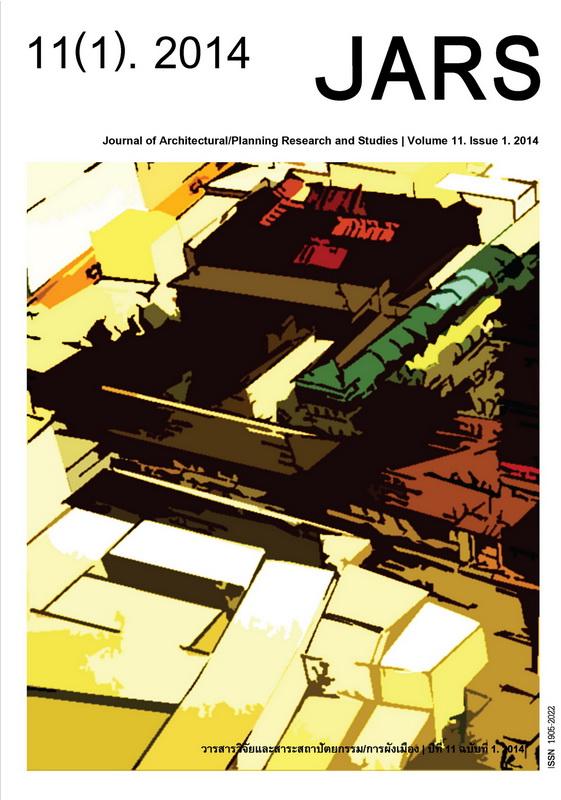Guidelines to Promote Cycling on University Campus: Case Study of Kasetsart University, Mahidol University and Thammasat University
Main Article Content
Abstract
The objectives of this research are to study means of transportation on university campuses and student opinions on bicycle use on university campuses. This research will also analyze difficulties and problems of cycling in order to offer practical guidelines to promote cycling on university campuses to meet student needs. The campuses where this research was performed are Kasetsart University (Bangkhen Campus), Mahidol University (Salaya Campus), and Thammasat University (Rangsit Center).
In this research, data was gathered by surveying the areas, and using questionnaires to collect 600 undergraduate student opinions about cycling on campus by using the quota sampling method (200 students per 1 university; 100 bicycle users and 100 non-users). According to the study, all 3 campuses have similar types of transportations: bicycle, cars, on foot and university public buses. In the past, a lot of students at Kasetsart University chose riding as their primary mode of transportation on campus, but the number has been decreasing. At present, Mahidol University succeeds in promoting greater cycling participation among students and in creating an environment suitable for cycling, while Thammasat University has just started its campaign on bicycle use. The main problems and difficulties of riding bicycles on campuses have been found to be the danger of the use of bicycles and unawareness of the benefits of riding bicycles. Thus, the guidelines to encourage the use of bicycles on campus are to provide a network of bicycle lanes and to improve existing parking space and presented bicycle lanes. Moreover, it would be helpful to have a campaign to encourage the use of bicycles, and to develope services for using public bicycles.
Downloads
Article Details

This work is licensed under a Creative Commons Attribution-NonCommercial-NoDerivatives 4.0 International License.
All material is licensed under the terms of the Creative Commons Attribution 4.0 International (CC-BY-NC-ND 4.0) License, unless otherwise stated. As such, authors are free to share, copy, and redistribute the material in any medium or format. The authors must give appropriate credit, provide a link to the license, and indicate if changes were made. The authors may do so in any reasonable manner, but not in any way that suggests the licensor endorses you or your use. The authors may not use the material for commercial purposes. If the authors remix, transform, or build upon the material, they may not distribute the modified material, unless permission is obtained from JARS. Final, accepted versions of the paper may be posted on third party repositories, provided appropriate acknowledgement to the original source is clearly noted.
References
Balsas, C. J. L. (2003). Sustainable transportation planning on college campuses. Transport Policy, 10(1), 35-49.
Boston University Parking and Transportation Services. (2013). Bike safty. Retrieved July 10, 2014, from http://www.bu.edu/bikesafety
Iamtrakul, P., Simcharean, P., & Jantawon, P. (2012). แนวทางศึกษาการวิจัยเชิงปฏิบัติการแบบมีส่วนร่วมเพื่อส่งเสริม ความปลอดภัยทางถนนเมือง: กรณีศึกษา เทศบาลเมืองท่าโขลง จังหวัดปทุมธานี [Participation of Local communities in road safety through participation research approach (PAR): A case study of Thankhlong municipality, Pathumthani]. Journal of architecture/planning research and studies, 9(1), 66.
New Jersey of Department Transportation. (2013). Bike RU initiative. Retrieved July 10, 2014, from http://bikes.rutgers.edu
Nucharee Arunkamol. (2010). The development of alternative transportation systems in Songkhla municipality. Master of Landscape Architecture Thesis, Faculty of Architecture, Chulalongkorn University, Bangkok, Thailand.
Pujinda, P. (2013). Handbook of physical design supporting bicycle use. Bangkok: Thaicyclingclub.
Schiller, P. L., Bruun, E. C., & Kenworthy, J. R. (2010). An introduction to sustainable transportation: policy, planning and implementation. London: Earthscan.
Srisurapanon, V, et al. (2003). Guideline for improvement the usage of bicycle in Bangkok. Bangkok: King Mongkut’s University of Technology Thonburi.
Stanford University, Parking & Transportation Services. (2013). Bike cycling at Stanford. Retrieved July 10, 2014, from http://transportation.stanford.edu
Transportation and Parking Service, Seattle University. (2013). Biking at SU. Retrieved July 10, 2014, from http://www.seattleu.edu
University of Minnesota, Parking and Transportation Services. (2013). Bike center. Retrieved July 10, 2014, from http://www1.umn.edu/pts/bike/bikecenter.html
Wongchaisuwan, A. (2009). Travel patterns of students in schools on Samsen road. Bangkok: Master of Urban and Regional Planning, Chulalongkorn University.
Suksen, D. (2009). Guidelines for development of greenway network in Nong Chok district, Bangkok: A case study of Koiruttakwa community. Master of Landscape Architecture Thesis, Faculty of Architecture, Chulalongkorn University, Bangkok, Thailand.

